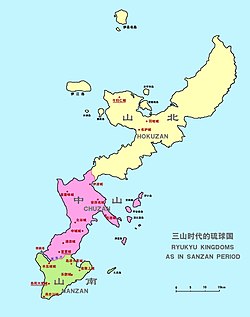Hokuzan
| Kingdom of Hokuzan | ||||||||
| 北山 | ||||||||
|
||||||||
|
Map of the Three Kingdoms (Sanzan) of Okinawa, with Hokuzan in yellow.
|
||||||||
| Capital | Nakijin | |||||||
| Languages |
Kunigami Okinawan |
|||||||
| Religion | Ryukyuan religion | |||||||
| Government | Monarchy | |||||||
| King (国王) | ||||||||
| • | 1322–1395 | Haniji | ||||||
| • | 1396–1400 | Min | ||||||
| • | 1401–1416 | Hananchi | ||||||
| History | ||||||||
| • | Established | 1314 | ||||||
| • | Ryukyu unification | 1416 | ||||||
| • | Japanese invasion | 5 April 1609 | ||||||
|
||||||||
Hokuzan (北山) was one of three kingdoms which controlled Okinawa in the 14th century. Okinawa, previously controlled by a number of local chieftains or lords, loosely bound by a paramount chieftain or king of the entire island, split into these three more solidly defined kingdoms within a few years after 1314; the Sanzan period thus began, and would end roughly one hundred years later, when Chūzan's King Shō Hashi conquered Hokuzan in 1416 and Nanzan in 1429.
Hokuzan first came into being in 1314 when Tamagusuku inherited the role of head chieftain of all of Okinawa from his father Eiji. He did not have the charisma or leadership qualities to command the loyalty of all the local lords, and so the Lord of Nakijin, one of many powerful local chieftains, decamped north with a number of lesser chieftains loyal to him and established himself in Nakijin Castle. Another powerful chieftain relocated into the south and established the kingdom of Nanzan, leaving Tamagusuku in control only of the central part of the island, which thus became the kingdom of Chūzan.
Though Hokuzan was the largest of the three kingdoms, it was also the poorest and the most sparsely populated. Much of its land was wild, and its few farming or fishing villages were more primitive than those of the other two kingdoms. Nakijin Castle (城 gusuku) stood on an outcropping of the Motobu Peninsula, with drops of varying steepness on every side; the ruins which remain today indicate the development of a community of fair size around it, including residences for the king's vassals, and three shrines (拝所 uganju) to the native religion within the castle walls.
In addition to its deficiencies in agriculture and fishing, Hokuzan suffered from the disadvantage, relative to Chūzan, of holding no port to equal Naha (O. Naafa). A small junk trade used the inlet below the castle's promontory as a dock, and later Unten harbor. Nevertheless, the northern kingdom engaged in its share of trade with many of the other states in the region, including Java, Sumatra, and the Ayutthaya Kingdom of Siam. Chūzan entered a tributary relationship with Ming Dynasty China in 1372, and Hokuzan and Nanzan were granted similar commercial status shortly afterwards.
...
Wikipedia

